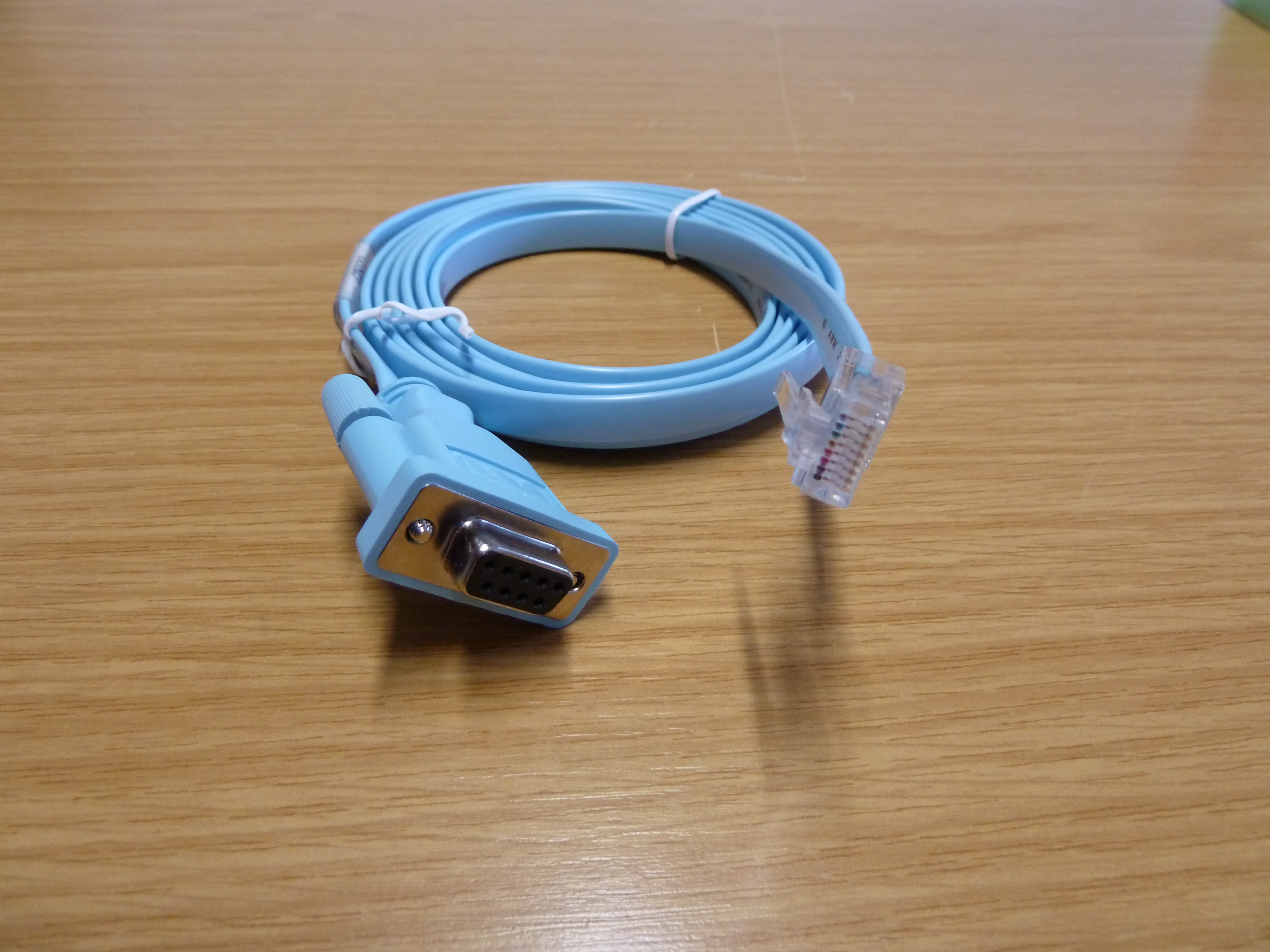|
Yost Cable
Rollover cable (also known as a Yost cable, Cisco cable, or a Console cable) is a type of null-modem cable that is used to connect a computer terminal to a router's System console, console port. This cable is typically flat (and has a light blue color) to help distinguish it from other types of network cabling. It gets the name rollover because the pinout, pinouts on one end are reversed from the other, as if the wire had been rolled over and you were viewing it from the other side. This cabling system was invented to eliminate the differences in RS-232, RS-232 wiring systems. Any two RS-232 systems can be directly connected by a standard rollover cable and a standard connector. For legacy system, legacy equipment, an adapter is permanently attached to the legacy port. See also * 8P8C * Serial cable * RS-232 References *Cisco Systems, CiscoCabling Guide for Console and AUX PortsDocument ID: 12223 [...More Info...] [...Related Items...] OR: [Wikipedia] [Google] [Baidu] |
Null-modem
Null modem is a communication method to directly connect two DTEs ( computer, terminal, printer, etc.) using an RS-232 serial cable. The name stems from the historical use of RS-232 cables to connect two teleprinter devices or two modems in order to communicate with one another; ''null modem'' communication refers to using a crossed-over RS-232 cable to connect the teleprinters directly to one another without the modems. It is also used to serially connect a computer to a printer, since both are DTE, and is known as a ''Printer Cable''. The RS-232 standard is asymmetric as to the definitions of the two ends of the communications link, assuming that one end is a DTE and the other is a DCE, e.g. a modem. With a null modem connection the transmit and receive lines are crosslinked. Depending on the purpose, sometimes also one or more handshake lines are crosslinked. Several wiring layouts are in use because the null modem connection is not covered by the RS-232 standard. Orig ... [...More Info...] [...Related Items...] OR: [Wikipedia] [Google] [Baidu] |
Computer Terminal
A computer terminal is an electronic or electromechanical hardware device that can be used for entering data into, and transcribing data from, a computer or a computing system. The teletype was an example of an early-day hard-copy terminal and predated the use of a computer screen by decades. Early terminals were inexpensive devices but very slow compared to punched cards or paper tape for input, yet as the technology improved and video displays were introduced, terminals pushed these older forms of interaction from the industry. A related development was time-sharing systems, which evolved in parallel and made up for any inefficiencies in the user's typing ability with the ability to support multiple users on the same machine, each at their own terminal or terminals. The function of a terminal is typically confined to transcription and input of data; a device with significant local, programmable data-processing capability may be called a "smart terminal" or fat client. A ter ... [...More Info...] [...Related Items...] OR: [Wikipedia] [Google] [Baidu] |
System Console
One meaning of system console, computer console, root console, computer operator, operator's console, or simply console is the text entry and display device for system administration messages, particularly those from the BIOS or boot loader, the Kernel (computer science), kernel, from the init system and from the syslog, system logger. It is a physical device consisting of a keyboard and a screen, and traditionally is a text terminal, but may also be a graphical terminal. System consoles are generalized to computer terminals, which are abstracted respectively by virtual consoles and terminal emulators. Today communication with system consoles is generally done abstractly, via the standard streams (stdin, stdout, and stderr), but there may be system-specific interfaces, for example those used by the system kernel. Another, older, meaning of system console, computer console, hardware console, operator's console or simply console is a hardware component used by an operator to control ... [...More Info...] [...Related Items...] OR: [Wikipedia] [Google] [Baidu] |
Pinout
In electronics, a pinout (sometimes written "pin-out") is a cross-reference between the contacts, or ''pins'', of an electrical connector or electronic component, and their functions. "Pinout" now supersedes the term "basing diagram" that was the standard terminology used by the manufacturers of vacuum tubes and the RMA. The RMA started its standardization in 1934, collecting and correlating tube data for registration at what was to become the EIA. The EIA (Electronic Industries Alliance) now has many sectors reporting to it, and sets what are known as EIA standards where all registered pinouts and registered jacks can be found. Purpose The functions of contacts in electrical connectors, be they power- or signaling-related, must be specified in order for connectors to be interchangeable. When connected, each contact of a connector must mate with the contact on the other connector that has the same function. If contacts of disparate functions are allowed to make contact, the conne ... [...More Info...] [...Related Items...] OR: [Wikipedia] [Google] [Baidu] |
RS-232
In telecommunications, RS-232 or Recommended Standard 232 is a standard originally introduced in 1960 for serial communication transmission of data. It formally defines signals connecting between a ''DTE'' (''data terminal equipment'') such as a computer terminal, and a ''DCE'' (''data circuit-terminating equipment'' or ''data communication equipment''), such as a modem. The standard defines the electrical characteristics and timing of signals, the meaning of signals, and the physical size and pinout of connectors. The current version of the standard is ''TIA-232-F Interface Between Data Terminal Equipment and Data Circuit-Terminating Equipment Employing Serial Binary Data Interchange'', issued in 1997. The RS-232 standard had been commonly used in computer serial ports and is still widely used in industrial communication devices. A serial port complying with the RS-232 standard was once a standard feature of many types of computers. Personal computers used them for connection ... [...More Info...] [...Related Items...] OR: [Wikipedia] [Google] [Baidu] |
Legacy System
In computing, a legacy system is an old method, technology, computer system, or application program, "of, relating to, or being a previous or outdated computer system", yet still in use. Often referencing a system as "legacy" means that it paved the way for the standards that would follow it. This can also imply that the system is out of date or in need of replacement. Legacy code is old computer source code that is no longer supported on the standard hardware and environments, and is a codebase that is in some respect obsolete or supporting something obsolete. Legacy code may be written in programming languages, use frameworks and external libraries, or use architecture and patterns that are no longer considered modern, increasing the mental burden and ramp-up time for software engineers who work on the codebase. Legacy code may have zero or insufficient automated tests, making refactoring dangerous and likely to introduce bugs. Long-lived code is susceptible to software rot, ... [...More Info...] [...Related Items...] OR: [Wikipedia] [Google] [Baidu] |
Legacy Port
In computing, a legacy port is a computer port or connector that is considered by some to be fully or partially superseded. The replacement ports usually provide most of the functionality of the legacy ports with higher speeds, more compact design, or plug and play and hot swap capabilities for greater ease of use. Modern PC motherboards use separate Super I/O controllers to provide legacy ports, since current chipsets do not offer direct support for them. A category of computers called legacy-free PCs omits these ports, typically retaining only USB for external expansion. USB adapters are often used to provide legacy ports if they are required on systems not equipped with them. Common legacy ports See also *Legacy encoding *Legacy system In computing, a legacy system is an old method, technology, computer system, or application program, "of, relating to, or being a previous or outdated computer system", yet still in use. Often referencing a system as "legacy" means that ... [...More Info...] [...Related Items...] OR: [Wikipedia] [Google] [Baidu] |
8P8C
A modular connector is a type of electrical connector for cords and cables of electronic devices and appliances, such as in computer networking, telecommunication equipment, and audio headsets. Modular connectors were originally developed for use on specific Bell System telephone sets in the 1960s, and similar types found use for simple interconnection of customer-provided telephone subscriber premises equipment to the telephone network. The Federal Communications Commission (FCC) mandated in 1976 an interface registration system, in which they became known as registered jacks. The convenience of prior existence for designers and ease of use led to a proliferation of modular connectors for many other applications. Many applications that originally used bulkier, more expensive connectors have converted to modular connectors. Probably the best-known applications of modular connectors are for telephone and Ethernet. Accordingly, various electronic interface specifications exist f ... [...More Info...] [...Related Items...] OR: [Wikipedia] [Google] [Baidu] |
Serial Cable
A serial cable is a cable used to transfer information between two devices using a serial communication protocol. The form of connectors depends on the particular serial port used. A cable wired for connecting two DTEs directly is known as a null modem cable. Maximum cable lengths The maximum working length of a cable varies depending on the characteristics of the transmitters and receivers, the baud rate on the cable, and the capacitance and electrical impedance of the cable. The RS-232 standard states that a compliant port must provide defined signal characteristics for a capacitive load of pF. This does not correspond to a fixed length of cable since varying cables have different characteristics. Empirically tested combinations of bit rate, serial ports, cable type, and lengths may provide reliable communications, but generally RS-232-compatible ports are intended to be connected by, at the most, a few tens of metres of cable. Other serial communications standards are better a ... [...More Info...] [...Related Items...] OR: [Wikipedia] [Google] [Baidu] |
Cisco Systems
Cisco Systems, Inc., commonly known as Cisco, is an American-based multinational corporation, multinational digital communications technology conglomerate (company), conglomerate corporation headquartered in San Jose, California. Cisco develops, manufactures, and sells networking hardware, software, telecommunications equipment and other high-technology services and products. Cisco specializes in specific tech markets, such as the Internet of Things (IoT), internet domain, domain security, videoconferencing, and energy management with List of Cisco products, leading products including Webex, OpenDNS, XMPP, Jabber, Duo Security, and Cisco Jasper, Jasper. Cisco is one of the List of largest technology companies by revenue, largest technology companies in the world ranking 74 on the Fortune 100 with over $51 billion in revenue and nearly 80,000 employees. Cisco Systems was founded in December 1984 by Leonard Bosack and Sandy Lerner, two Stanford University computer scientists who ... [...More Info...] [...Related Items...] OR: [Wikipedia] [Google] [Baidu] |
Out-of-band Management
In systems management, out-of-band management involves the use of management interfaces (or serial ports) for managing networking equipment. Out-of-band (''OOB'') management is a networking term which refers to accessing and managing network infrastructure at remote locations, and doing it through a separate management plane from the production network. Cellular 4G and 5G networks are used today for out-of-band management and many manufacturers have it as a product offering. Out-of-band management is now considered an essential network component to ensure business continuity. Out-of-band management allows the network operator to establish trust boundaries in accessing the management function to apply it to network resources. It also can be used to ensure management connectivity (including the ability to determine the status of any network component) independent of the status of other ''in-band'' network components. In computing, one form of out-of-band management is sometimes ca ... [...More Info...] [...Related Items...] OR: [Wikipedia] [Google] [Baidu] |





